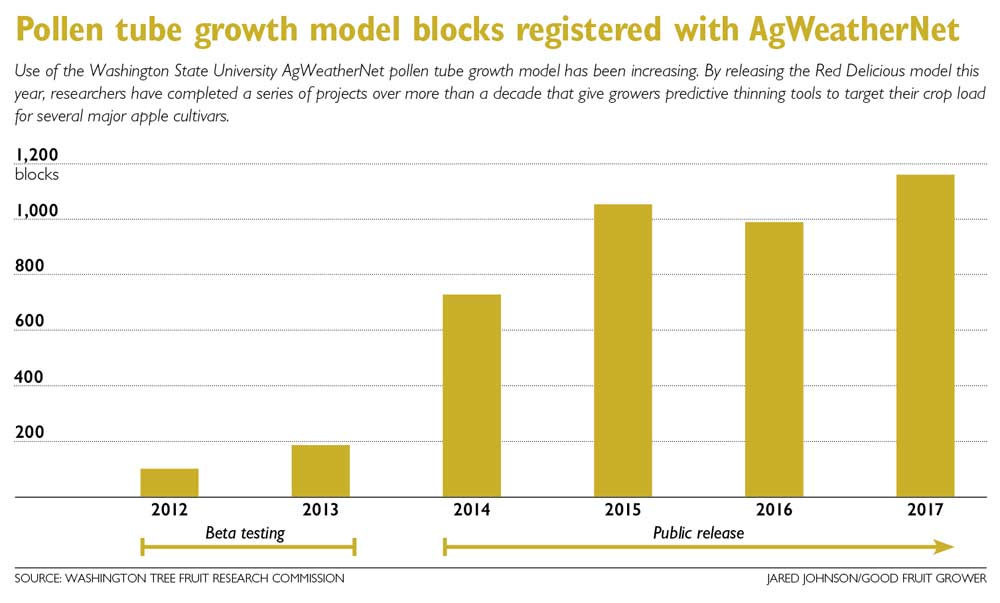
Pollen tube growth model blocks registered with AgWeatherNet: Use of the Washington State University AgWeatherNet pollen tube growth model has been increasing. By releasing the Red Delicious model this year, researchers have completed a series of projects over more than a decade that give growers predictive thinning tools to target their crop load for several major apple cultivars. (Source: Washington Tree Fruit Research Commission. Graphic by Jared Johnson/Good Fruit Grower)
First came Gala, then Golden Delicious, then Fuji, Cripps Pink, Honeycrisp and Granny Smith.
And last but not least, researchers have released the pollen tube growth model for the Red Delicious apple cultivar, closing the books on a series of projects over the past 11 years designed to give growers tools to target their crop load more precisely.
“We see this as more than just the final report for the current Red Delicious project,” wrote Keith Yoder, the Virginia Tech University researcher who led the projects for most of those years, to the Washington Tree Fruit Research Commission. “Release of the Red Delicious model completes our assigned series of related projects with WTFRC.”
Fellow researcher Sherif Sherif presented his findings at the Apple Research Review in January in Pasco, Washington, telling growers the Red Delicious model will be added this year to the list of other cultivar models on AgWeatherNet, the Washington State University weather network.
The pollen tube growth model provides growers with information to more strategically apply chemical thinners by estimating the time necessary for freshly pollinated flowers to become fertilized based on growth rates of the pollen tubes, average flower style lengths and current weather data. The web-based models are hosted on AgWeatherNet at weather.wsu.edu.
The Research Commission funded the two-year Virginia Tech Red Delicious project to the tune of $33,280. Overall, the Research Commission has spent about $672,000 on Virginia Tech’s pollen tube research since 2008. In 2017, nearly 1,200 apple blocks were registered to use the model, according to AgWeatherNet statistics, said Tory Schmidt, project manager for the Research Commission.
The recent project specifically aimed to validate that the Red Delicious pollen model works. The answer: yes. “Reported harvest data showed that the pollen tube growth model is helping growers to achieve their targeted crop loads,” researchers wrote.
The researchers collaborated with growers in 100 commercial blocks in 2016-2017, reporting spray timing and yield data, counting flowers and measuring pollen tubes. They also sent flower samples to Virginia Tech for testing for evidence of fertilization.
Crunching the data, the researchers compared the volumes of the desired harvest and the actual harvest, finding them quite similar in most cases.
“Of course, if these values are the same, it means the model is accurate,” Sherif said at the research review.
They needed to validate the model for each cultivar individually because pollen tubes grow at different rates. Studies since 2007 show Red Delicious is the slowest major cultivar, mostly because pollen grains remain inactive on the flowers for a time before germinating. This latency period makes Red Delicious difficult to model, so growers may experience more variable results than for other varieties.
Before the pollen tube models, growers often timed chemical thinners by “gut feel” or followed standard guidelines, such as applying at 20 percent and 80 percent bloom.
Though the Red Delicious model validation wraps up the scheduled series of projects, the researchers wish to study more, they said. New cultivars are coming out and different pollinizer varieties will affect fertilization rates. Up until now, research has used Snowdrift as the default pollinizer.
The Research Commission has discussed those topics but has not made any specific plans to fund further research, Schmidt said. •
—by Ross Courtney






Leave A Comment